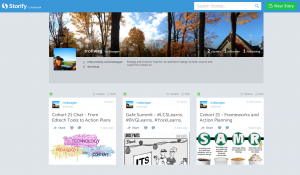
Similar to Facebook, you are able to set up a profile where all your Storify articles are stored. You can also follow and share with others.
Twitter and Storify – Enhancing and Archiving for Learning
The power of sharing in an isolated event such as a Twitter chat can be a motivating, collaborative, and unique way to stimulate the minds of our students. A couple weeks ago, I ran my first Twitter chat with the Cohort 21 crew on educational frameworks and action planning as a professional development technique. After completing the Twitter chat, I wanted to capture the questions, ideas, and resources that the Cohort 21 community shared. I had heard of Storify before but hadn’t used it as a tool to capture and archive resources. It was super easy and made it into a very organized and easy to read format. Unfortunately, WordPress won’t embed Storify due to security reasons but you can still see the link below to view the recent chat on Ed-tech Frameworks such as SAMR, TPACK, and TIM and get an idea of how it works. This was the first time that I had seen the value of Storify for my learning as a teacher and potentially for my students.
In the weeks following, a group of teachers at my school, and various other independent schools in Ontario, attended the GAFE Summit in Montreal, which in itself is an amazing PD opportunity. Again, it was a time where many people were sharing their resources, ideas, and views via Twitter. As I wished to capture the conversation, Storify allowed me to compile the resources that were shared via the #GafeSummit hashtag for future use.
After my experience with the archiving site, Storify. Brent Hurley, a fellow Cohort 21 Coach, and myself began discussing ways in which we could use Twitter to enhance the learning within our classrooms. After much discussion, we were both able to come up with a meaningful way to use Twitter in the classroom and capture the moments via Storify.
In Brent’s AP English class, he set up a hashtag unique to his classroom and posed questions to stimulate conversation between his students. He then archives the conversation through Storify so the kids can access the conversation in an easy and organized platform. It’s a unique way to integrate social media into the classroom in a way that also demonstrates what good digital citizenship looks like. The students essentially learn how to create their own personal learning community (PLC) within their own class.
- Use a hashtag to keep the conversation in one place and between select individuals.
- Pre-discuss good questions that could stimulate sharing and conversations.
- Have a limited time and date for them to carry out their discussion.
- Have students create topics to be discussed.
- Carry out a ‘mock’ chat in class to show how it is done.
- Discuss the importance of digital citizenship


Tim, I was so excited to work with you and Mike in helping to get his Twitter ideas off the ground. I think that what Brent is doing in class, is of excellent value too.
Twitter can be an excellent sharing tool but also a research tool! As can Diigo. I like Storify and something you might want to use in class is Twitter fontana which changes the tweets that are happening with the hashtag in real time. It would be neat to start the class with what was shared the day before and then ask them to vote for what best described the essence of class or which question they’d like to explore in that class.
Great job on the Twitter chat as well! I want to host one this year but I am a little nervous. Oh well, it’s about putting yourself out there right!? I really love working with you!
Thanks to YOU Doucet. Always a pleasure working with you and I agree, sometimes it’s all about putting yourself out there. What’s the worst that can happen. Thanks for the Twitter Fontana suggestion too, it would be great to have in the background of a class discussion.
You’re a beauty. Looking forward to your next post!